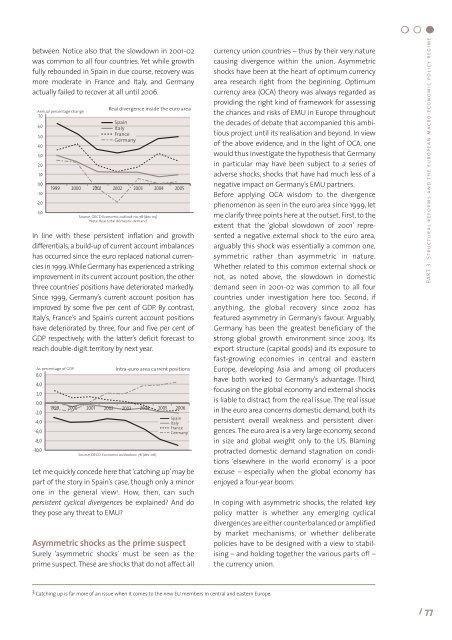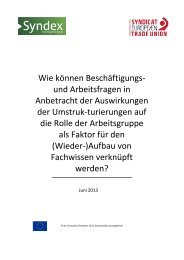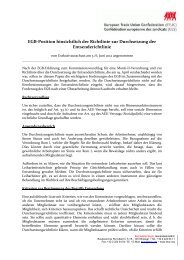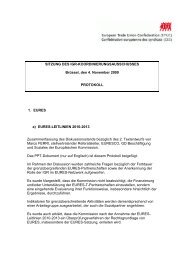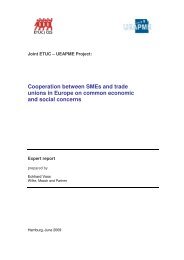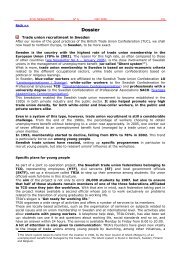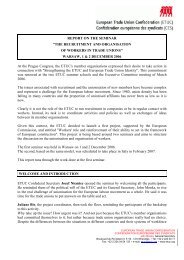Structural reforms and macro-economic policy - ETUC
Structural reforms and macro-economic policy - ETUC
Structural reforms and macro-economic policy - ETUC
Create successful ePaper yourself
Turn your PDF publications into a flip-book with our unique Google optimized e-Paper software.
etween. Notice also that the slowdown in 2001-02<br />
was common to all four countries. Yet while growth<br />
fully rebounded in Spain in due course, recovery was<br />
more moderate in France <strong>and</strong> Italy, <strong>and</strong> Germany<br />
actually failed to recover at all until 2006.<br />
Annual percentage change<br />
7,0<br />
6,0<br />
5,0<br />
4,0<br />
3,0<br />
2,0<br />
1,0<br />
0,0<br />
-1,0<br />
-2,0<br />
-3,0<br />
Real divergence inside the euro area<br />
Spain<br />
Italy<br />
France<br />
Germany<br />
1999 2000 2001 2002 2003 2004 2005<br />
Source, OECD Economic outlook no. 78 (dec 05)<br />
Note. Real total domestic dem<strong>and</strong><br />
In line with these persistent inflation <strong>and</strong> growth<br />
differentials, a build-up of current account imbalances<br />
has occurred since the euro replaced national currencies<br />
in 1999.While Germany has experienced a striking<br />
improvement in its current account position, the other<br />
three countries’ positions have deteriorated markedly.<br />
Since 1999, Germany’s current account position has<br />
improved by some five per cent of GDP. By contrast,<br />
Italy’s, France’s <strong>and</strong> Spain’s current account positions<br />
have deteriorated by three, four <strong>and</strong> five per cent of<br />
GDP respectively, with the latter’s deficit forecast to<br />
reach double-digit territory by next year.<br />
As percentage of GDP<br />
6,0<br />
4,0<br />
2,0<br />
0,0<br />
-2,0<br />
-4,0<br />
-6,0<br />
-8,0<br />
-10,0<br />
Intra-euro area current positions<br />
1999 2000 2001 2002 2003 2004 2005 2006<br />
Source, OECD Economic outlookno. 78 (dec 06)<br />
Spain<br />
Italy<br />
France<br />
Germany<br />
Let me quickly concede here that ‘catching up’may be<br />
part of the story in Spain’s case, though only a minor<br />
one in the general view 3 . How, then, can such<br />
persistent cyclical divergences be explained? And do<br />
they pose any threat to EMU?<br />
Asymmetric shocks as the prime suspect<br />
Surely ‘asymmetric shocks’ must be seen as the<br />
prime suspect.These are shocks that do not affect all<br />
3 Catching up is far more of an issue when it comes to the new EU members in central <strong>and</strong> eastern Europe.<br />
currency union countries – thus by their very nature<br />
causing divergence within the union. Asymmetric<br />
shocks have been at the heart of optimum currency<br />
area research right from the beginning. Optimum<br />
currency area (OCA) theory was always regarded as<br />
providing the right kind of framework for assessing<br />
the chances <strong>and</strong> risks of EMU in Europe throughout<br />
the decades of debate that accompanied this ambitious<br />
project until its realisation <strong>and</strong> beyond. In view<br />
of the above evidence, <strong>and</strong> in the light of OCA, one<br />
would thus investigate the hypothesis that Germany<br />
in particular may have been subject to a series of<br />
adverse shocks, shocks that have had much less of a<br />
negative impact on Germany’s EMU partners.<br />
Before applying OCA wisdom to the divergence<br />
phenomenon as seen in the euro area since 1999, let<br />
me clarify three points here at the outset. First, to the<br />
extent that the ‘global slowdown of 2001’ represented<br />
a negative external shock to the euro area,<br />
arguably this shock was essentially a common one,<br />
symmetric rather than asymmetric in nature.<br />
Whether related to this common external shock or<br />
not, as noted above, the slowdown in domestic<br />
dem<strong>and</strong> seen in 2001-02 was common to all four<br />
countries under investigation here too. Second, if<br />
anything, the global recovery since 2002 has<br />
featured asymmetry in Germany’s favour. Arguably,<br />
Germany has been the greatest beneficiary of the<br />
strong global growth environment since 2003. Its<br />
export structure (capital goods) <strong>and</strong> its exposure to<br />
fast-growing economies in central <strong>and</strong> eastern<br />
Europe, developing Asia <strong>and</strong> among oil producers<br />
have both worked to Germany’s advantage. Third,<br />
focusing on the global economy <strong>and</strong> external shocks<br />
is liable to distract from the real issue. The real issue<br />
in the euro area concerns domestic dem<strong>and</strong>, both its<br />
persistent overall weakness <strong>and</strong> persistent divergences.The<br />
euro area is a very large economy, second<br />
in size <strong>and</strong> global weight only to the US. Blaming<br />
protracted domestic dem<strong>and</strong> stagnation on conditions<br />
‘elsewhere in the world economy’ is a poor<br />
excuse – especially when the global economy has<br />
enjoyed a four-year boom.<br />
In coping with asymmetric shocks, the related key<br />
<strong>policy</strong> matter is whether any emerging cyclical<br />
divergences are either counterbalanced or amplified<br />
by market mechanisms, or whether deliberate<br />
policies have to be designed with a view to stabilising<br />
– <strong>and</strong> holding together the various parts of! –<br />
the currency union.<br />
PART 3: <strong>Structural</strong> <strong>reforms</strong> <strong>and</strong> the european <strong>macro</strong>-<strong>economic</strong> <strong>policy</strong> regime<br />
/ 77


